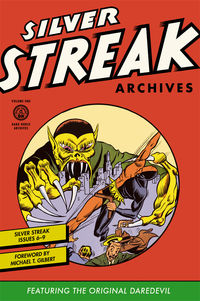The Need For Speed! Archive Intro by Michael T. Gilbert
SILVER STREAK ARCHIVES FEATURING THE ORIGINAL DAREDEVIL VOLUME 1
 On paper, Silver Streak had everything he needed to become a star.
On paper, Silver Streak had everything he needed to become a star.
Cool name? Check! Neat costume? Check! Top-notch artist? Check! But when the dust finally settled, a minor bit player took home the Oscar award!
Silver Streak himself was actually something of an afterthought. A hero by that name didn’t even exist when Arthur Bernhardt published the first issue of Silver Streak in December 1939. Instead we got Mister Midnight, the Wasp, Spiritman, and swashbuckling adventurer Captain Fearless. Not a winner in the bunch. Oddly enough, the main feature wasn’t a hero at all. He was the Claw, master of evil—but more on him later.
Silver Streak, who was introduced in Silver Streak Comics #3, wore no tights or cape. He was just a guy hired to drive the Silver Streak, the fastest racing car in the world. This origin tale even came with a little back story: the previous driver had died under mysterious circumstances, killed by a giant insect stinger during a race! After the accident, the Silver Streak racer was rebuilt to be even faster, but no one was brave enough to drive it until an unemployed taxi driver applied for the job.
The car’s evil-looking Arabic owner stared into the taxi driver’s eyes and hypnotized him with these words: “You are the Silver Streak––the strongest, bravest, fastest man in the world! Do you understand? The Swami speaks!”
Apparently the cabbie was listening, because he soon tore up a racetrack like a pro. But once again disaster struck! A fifty-foot fly-monster upended the speeding car, sending the driver to his death. When he was buried shortly after, it looked like readers had just been treated to the shortest origin story in comic book history.
Ah, but looks can be deceiving! That night, the swami and his henchman dug up our nameless hero’s corpse. “His death, the Swami believes, is merely a hypnotic trance,” said the fellow, peering into lifeless eyes, “But what his mental condition will be, only Allah knows!!” All of a sudden, our boy woke from the dead! Now supernaturally strong, he tossed both men aside and vanished into the night. “It is as I feared,” wailed the Swami, “The hypnosis has become part of his mind . . . he is now all-powerful, a man to be feared!”
Indeed he was. The revived corpse broke into the auto factory and zoomed out with the latest Silver Streak. Then he blew up the place, making sure no one copied the muscle car to end all muscle cars.
A page later, the giant fly returned. After a furious struggle, our fearless hero flung it into outer space. In the last panel, mad Dr. Katan (“an insane professor of zoology”) revealed his sinister creation: a serum that super-sizes bugs into monsters. True to type, he vowed to destroy the hero now known as Silver Streak—and readers couldn’t wait to see the fight!
By the next issue, the car was gone, without explanation. So was the Swami. But the hero, now known as Silver Streak, sported a handsome new costume, courtesy of Jack “Ralph Johns” Cole. Oddly enough, the Streak’s uniform wasn’t silver at all, but drab purple and green with a touch of red.
No matter. The costume looked cool, and the art was a huge upgrade over Jack Binder’s earlier version. This new, improved Streak also wore special “suction shoes” that allowed him to race up the sides of buildings like a hyperactive spider.
The script, almost certainly by Cole, was terrific fun. An amusing side plot featured a dotty dowager seeking his assistance. At various times she refers to him as Mr. Gold Streak, Mr. Copper Streak, Mr. Steel Streak, Mr. Iron Streak, Mr. Lead Streak and Mr. Brass Streak. An old gag, to be sure, but a good one!
Cole’s splash panel that issue also featured a mini-origin of sorts. “Who is Silver Streak? A shapeless blur rocketing at an invisible speed across the countryside––a swishing sound that leaves but the breeze against one’s face as evidence of his passing presence. This is Silver Streak, the fastest man imaginable!” Pure poetry!
This Silver Streak could fly, and—as promised in the previous issue—once again battled and defeated the terrible fly. An auspicious beginning, and a promise of greater things to come.
By Silver Streak Comics #7, the Streak had traded in his drab purple uniform for a red model with flashy gold trim. He also acquired a high-flying partner: Whiz––King of Falcons.
And of course, this being the early 1940s, the Streak was also saddled with a kid partner. This spunky lad was named Mercury, er, I mean Meteor . . . er, I mean . . .
Actually the kid was named “Mercury . . . The Boy Streak” in issue #11, and then next issue, without explanation, became Meteor . . . The Boy Speed King!” No matter. By any name the kid was still dead weight.
And speaking of names . . .
“Silver Streak” was likely inspired by the Pioneer Zephyr, a train generally regarded as the first successful American railroad streamliner. Nicknamed the Silver Streak, it set a speed record on May 26, 1934, for travel between Denver, Colorado, and Chicago, Illinois––at one point reaching speeds of 112.5 miles per hour, just short of the previous record of 115 miles per hour. The train also inspired two movies. The first, a 1934 RKO potboiler, actually removed the train’s Pioneer Zephyr sign for the film, replacing it with one sporting a Silver Streak logo.
But another story traces the name to the original publisher Arthur Bernhardt, who owned a Pontiac Silver Streak car. The term "silver-streak" referred to a body detail peculiar to Pontiacs manufactured from 1935 to 1956. A five-banded, chromed metal band ran down the middle of the hood and trunk to create the illusion of speed. This Art Deco flourish also helped to distinguish Pontiacs from their competitors. You pays yer money, and you takes yer choice.
So with that cool name and Jack Cole’s brilliant cartooning, it seemed inevitable that the Silver Streak would emerge as the company’s breakout superstar.
Only it didn’t work out that way.
A new backup feature called Daredevil stole the show. Or rather, The Daredevil . . . Master of Courage, as he was billed in his Silver Streak Comics #6 debut.
It’s not known who scripted the first Daredevil story, but Jack Binder drew it. Binder is also generally credited with illustrating the unsigned premiere Silver Streak episode. Binder was the older brother of Captain Marvel’s chief writer, Otto Binder. Brother Jack also drew the adventures of the Captain’s high-flying sister, Mary Marvel for Fawcett. His art was serviceable, if a bit dull.
Interestingly, another Jack––Jack Cole––took over both titles with their second episodes, streamlining both costumes in the process. Hired in 1939 to edit Silver Streak Comics, the 24-year-old Cole certainly delivered.
Jack Cole was lightning in a bottle––a truly brilliant cartoonist and scripter. Unfortunately, he didn’t stay long. Cole left to work for the rival Quality Comics. There he created Plastic Man, the stretchable sleuth who became his most beloved character. But before he moved on, Cole perfected the visual template for Daredevil later employed by Charles Biro and other artists.
Daredevil’s origin story was a strange one. Criminals hot to steal a valuable invention murdered the parents of young Bart Hill—and then branded him, leaving the boy with a boomerang-shaped scar on his chest. Later Bart would pay them back, exacting revenge with a real boomerang. The origin would change in future issues, but that was how it started.
The torture scene inflicted on the young boy on Binder’s splash page displayed shocking brutality. Such low-rent sensationalism would become a hallmark of the series. Many early covers for Lev Gleason Publication’s Boy, Daredevil, and Crime Does Not Pay series featured even more gruesome scenes of cruelty and depravity.
In that first story, the torture renders Bart mute, a conceit mercifully ignored by Cole when he took over with episode two. Strangely enough, Stan Lee created a new version of Daredevil in 1964 who was blind.
Under Cole’s sure hand, the new Daredevil feature quickly gathered steam. By issue #7 he had grabbed the lead position from Silver Streak. That comic also featured one of the earliest and greatest comic book crossovers of the Golden Age. In sixteen glorious pages, Jack Cole orchestrated a rock-’em-sock-’em battle between Daredevil and the insidious Claw!
As mentioned earlier, the Claw, another Cole creation, was the lead feature in the first issue of Silver Streak Comics. This yellow-skinned monster (briefly renamed the Green Claw) was a villain in the classic Fu-Manchu mold, similar to Marvel’s subsequent Yellow Claw. But Cole’s version was even more dangerous. He could grow into a monstrous mile-high, man-eating “Yellow Peril!” In early issues, The Claw battled Jerry Morris, a two-fisted American scientist-adventurer. Needless to say, the offensive ethnic stereotypes so common to the era would never fly today.
But Cole’s exuberant layouts and dynamic storytelling in the first Daredevil/Claw showdown are readily apparent. Less obvious are the quiet, subtle moments that Cole brought to the table.
Check out page three, for example. Bart Hill and his girlfriend Tonia are fishing. He hooks one while they debate the incongruity of waging war to ensure peace. Using a beautifully constructed parallel structure, Cole shows Bart struggling to land a fish while it desperately fights to escape. The sequence has a power and sensitivity rare in comics then or now.
In the end, Daredevil not only defeats The Claw, he promises a return match, which was kept the following issue. Sadly, the art in this confrontation and one that followed appears rushed. Perhaps Cole only provided layouts or rough pencils as he transitioned from Gleason Publications to Quality.
By issue #9 Daredevil kept his lead story position, but now the Silver Streak sped past him to grab the cover spot. Newcomer Bob Wood, who also illustrated the issue’s Silver Streak story, drew the cover. In the coming months, Wood emerged as a major player at Gleason Publications, eventually co-editing (with Charles Biro) their comic book line. Biro, a visionary artist and writer, became Gleason’s #1 man upon Cole’s departure.
We don’t have space for a complete listing of Silver Streak’s backup features. For the most part they were the usual Golden Age hodgepodge of characters and genres of varying quality. In any given issue you might find straight-shootin’ air ace Sky Wolf, or straight-shootin’ cowpoke Bill Wayne, the Texas Terror! To save money, some of these stories appeared in only red and black, as was common back in those days.
A few features did stand out, like Jack Cole’s (him again?) swashbuckling Pirate Prince. Dick Briefer, who drew Prize Comics’s popular Frankenstein series, soon took over, retaining Cole’s blend of humor and adventure.
Fred Guardineer, the first artist to draw DC’s Zatara the Magician, also did the honors on Lance Hale, yet another fearless Tarzan knockoff. Joe Simon’s short-lived sci-fi epic, Solar Patrol, was another. And let’s not forget Bob Wood’s “Presto” Martin––Quick Change Artist! Great name for a bank teller or Wal-mart cashier, huh?
Best of all was Jack Cole’s Dickie Dean, Boy Inventor. A precocious lad, Dickie often whipped up stuff like a “walking submarine” or an anti-gravity “Sky Bug,” also known as the “flying bathtub!” In his spare time, the clever tyke fought crime with his pals. Funny thing was, Dickie was often decades ahead of his time. To flush out a killer in issue #7, Dickie floated a balloon above the city with a special attached camera. “The camera took a picture of the entire city every ten seconds,” he explains. “But this selector lens will magnify any part of the photo desired!” Sounds like Google Earth to me! The series was lots of fun, and Cole clearly enjoyed himself.
But Daredevil remains Silver Streak’s only real breakout character. By early 1941, Gleason knew he had a winner and made plans for a Daredevil spin-off. The Master of Courage had one final cover appearance in Silver Streak #12 in July 1941, right when Daredevil’s own comic hit the stands.
The title says it all: Daredevil Battles Hitler! Once you’ve punched out The Claw, who else is left?
Under Biro’s guidance, the Golden Age Daredevil sold millions during an impressive 134-issue run, but Silver Streak Comics fizzled after only twenty-three issues. When push came to shove, the Silver Streak just didn’t have Daredevil’s star power.
Before we go, let’s take a moment to remember poor Silver Streak. Fast as he was, he just couldn’t beat Daredevil in the race for fame and fortune . . . but he sure gave him a run for his money!
—Michael T. Gilbert
January 2012
Michael T. Gilbert has been a professional cartoonist since 1973, writing or illustrating stories featuring Superman, Batman, Dr. Strange, Donald Duck, Bart Simpson, and other charters, as well as his own monster-fighting superhero, Mr. Monster––currently appearing in Dark Horse Presents. Michael’s produced over a hundred columns on comic book history for Alter Ego magazine since 1998. In 2009, he also wrote and drew a new story for Image’s Next Issue Project: Silver Streak #24 featuring Jack Cole’s Claw.



